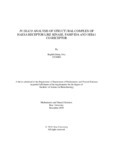| dc.contributor.advisor | Mubassir, M H M | |
| dc.contributor.author | Alvy, Raghib Ishraq | |
| dc.date.accessioned | 2020-02-16T05:56:11Z | |
| dc.date.available | 2020-02-16T05:56:11Z | |
| dc.date.copyright | 2019 | |
| dc.date.issued | 2019-12 | |
| dc.identifier.other | ID 15236001 | |
| dc.identifier.uri | http://hdl.handle.net/10361/13759 | |
| dc.description | This thesis is submitted in partial fulfillment of the requirements for the degree of Bachelor of Science in Biotechnology, 2019. | en_US |
| dc.description | Cataloged from PDF version of thesis. | |
| dc.description | Includes bibliographical references (pages 60-68). | |
| dc.description.abstract | Pattern Triggered Immunity (PTI) is actually identified by the activities of pattern recognition
receptors (PRRs), which play the most important role in first layer of plant defense mechanism.
During aggression of microbes, PRRs immediately bind with the pathogen-associated molecular
patterns (PAMPs) and recruit co-receptor protein(s) to activate the defense signal and begin plant's
immunity. Although several plant PRRs have been discovered, very few of them have been fully
characterized and their functional parameters studied. In this study, the crystallographic structure
of HAESA-IDA-SERk1 (PDB ID: 5IYX) complex was simulated for 30 ns in different stages like
there were five different combinations of the main crystallographic structure. For every
combination 30ns simulated trajectories were analyzed for getting an overview of the interaction
and immune response of HAESA towards IDA with the help of co-receptor SERk1. Analyzing the
interaction revealed its remarkable resemblance to the other crystallographic structures, which are
also a member of the same LRR-RK subfamily (leucine-rich repeat – receptor kinase subfamily
XII). Furthermore, it was observed that Tyr56 and Arg67 of IDA contributed significantly to the
formation of the HAESA-IDA complex. It can thus be predicted that any change to the PAMP at
these positions can be greatly detrimental to the plant, leading to the PRR losing its ability to
recognize the PAMP. Moreover, from MM/PBSA analysis it is found that binding energy between
HAESA and IDA is more favourable than HAESA and SERk1. -636.824 kJ/mol binding energy
is found when co-receptor SERk1 is present inside the complex and during its absence the binding
energy between HAESA and IDA goes higher. Again, a notable binding energy between IDA and
SERk1 is obtained from this analysis. There are several prominent residues found from HAESA
and SERk1, mutation at any of these residues will affect on PTI of Arabidopsis thaliana. Since
HAESA has been shown to play a key role in Arabidopsis thaliana plant defense mechanism, its
hypothesized binding mechanism with IDA and co-receptor SERk1 will help paint a better
understanding of the inceptive stages of PTI. | en_US |
| dc.description.statementofresponsibility | Raghib Ishraq Alvy | |
| dc.format.extent | 69 pages | |
| dc.language.iso | en | en_US |
| dc.publisher | Brac University | en_US |
| dc.rights | Brac University theses are protected by copyright. They may be viewed from this source for any purpose, but reproduction or distribution in any format is prohibited without written permission. | |
| dc.subject | Pattern Triggered Immunity (PTI) | en_US |
| dc.subject | HAESA receptor | en_US |
| dc.subject | PAMP IDA | en_US |
| dc.subject | SERk1 co-receptor | en_US |
| dc.title | In silico analysis of structural complex of HAESA receptor like kinase with PAMP IDA and SERk1 co-receptor | en_US |
| dc.type | Thesis | en_US |
| dc.contributor.department | Department of Mathematics and Natural Sciences, Brac University | |
| dc.description.degree | B. Biotechnology | |

